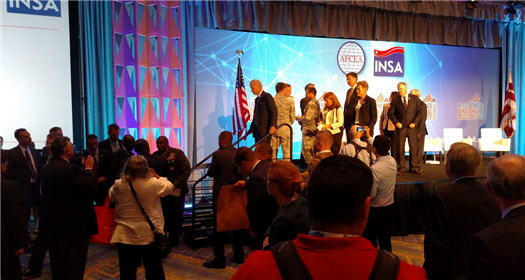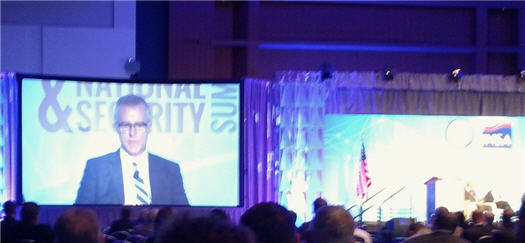
(The Big Six are departing the stage after the fifth and final plenary session of the Intelligence & National Security Summit. John Brennan has already been enveloped by his CIA security detail and whisked away before I could get any closer with my smart phone. Lieutenant General Vince Stewart (DIA) is on the bottom of the stairway to left center. Robert Cardillo (NGA) is just starting down the stairs. Talking to two soldiers in cammies is Admiral Mike Rogers (NSA/CYBERCOM). Tish Long (INSA CHAIR) is in the chic white suit in the center. She is followed by Dr. Betty Sapp (NRO), Eric Schmitt (Moderator and NY Times correspondent) and the impressively tall James Comey (FBI). At right are legendary analyst Maureen “Mo” Baginsky (AFCEA) and Chuck Alsup (INSA). I have never seen this amazing confluence of intelligence senior officials in one place before. Photo Socotra).
I as conventioning this week, courtesy of Syntelligent Analytic Solutions, the premier HUBZone purveyor of analysts and applications to the IC and it was very cool. Billed as the “Intelligence & National Security Summit,” the conference’s grand title gathered most of the people in this town- and the larger world who actually know what is going on, and occasionally actually do something about it. The two major intelligence professional groups- INSA and AFCEA- joined forces to sponsor the event, and got AT&T, CISCO, Noblis and Oracle onboard as “Premier Sponsors” to provide refreshments and food.
It was nicely done.
The Honorable Tish Long, former Director of the National Geospatial Intelligence Agency kicked the thing off on Wednesday, bright and early at the Harold Washington Convention Center downtown by introducing my old Boss Jim Clapper, the longest-serving Director of National Intelligence. He spoke for a while about his life and times in the trade, and he mentioned that the Summit was a very useful forum to convey messages and roll out IC-wide initiatives. At the first one of these events two years ago, he rolled out the 2014 National Intelligence Strategy, which included principles of professional ethics for the Intelligence Community.
I support that. And last year, he rolled out the principles of intelligence transparency in response to the Snowden treason and the Chelsea Manning leaks. We heard more about the Transparency Working Group, which is now apparently a permanent council charged with letting the public know what we spooks are up to without compromising sensitive sources and methods.
The General took a light tone, recognizing that “In about two months, 62 days to be exact, we’ll know who the next President will be, hopefully. And many of the faces and names at the top of the national security structure will probably accordingly change.”
That is a safe bet, and this year is not the time to roll anything more out- “Except for me,” he concluded to broad laughter in the packed hall. Then he sat down with Tish Long to answer her questions and take an extensive number of inquiries sent by email to the convention command center.
It was pretty amazing seeing who all was there. In addition to the heavy hitters, there were risk managers from the private sector to comment on the protection of our money from hackers and identity thieves.
Getting there was half the fun. I don’t take the Metro any more, for perfectly rational reasons that have little to do with track safety or shoddy maintenance. I don’t trust my legs any more, and to the degree that I could, I wanted to minimize walking.
Anyway, it was kinda cool to just take a Red Top cab from Big Pink in the appalling traffic downtown and just look out the window from the backseat at the astonishing things the drivers around us were doing. It is how your government gets to work each day, and it is an urgent and relentless flow.
Following the Plenary sessions, there were three break-out groups concentrating on Cyber issues, Policy matters, and the Enduring and Future Issues with the astonishing Charlie Allen, who appears to be working as hard as ever at The Chertoff Group. The former DHS Secretary was there as well.
It was tough to decide which of the tracks to monitor. I wound up in the Policy Track, since RDML Tony Cothron was moderating the panel about the insider threat and our entire creaky security clearance system. All of us- and I mean all of us who have, or had security clearances- had our personal security investigation results stolen by hackers in the OMB fiasco, so we take the matter seriously. The SF-86 forms we all filled out have the crown jewels of identity all over them. Everything. As one of the panelists noted, this is a cyber bomb that may take a quarter century to be detonated.
We did Acquisition matters in the afternoon with our pal Ellen McCarthy moderating. She and the panelists did a great job, but the key problem in the business these days is the government’s use of ‘Lowest Cost, Technically cfAcceptable (LPTA)” criteria for issuing contracts. LPTA delivers unrealistic pricing, which makes it impossible to staff these vital tasks with qualified personnel. The system is broken, and the matter never came up in the panel.
Day Two started off with a brace of Congressmen from the HPSCI (Nunes-R and Schiff-D) who were remarkably free of the inter-party acrimony that seems to pervade all our political discourse these days. Following them was a panel on the Homeland Security enterprise, which featured the coolest major city police chief in the country, Kathy Lanier, one of my heroes. But the most amazing figure was the Honorable John Carlin, Chief of the national Security Division at the FBI. He looked like he could have been teleported direct from the bureaucracy of 1967:

But it was at the break-out session on Future Issues that grabbed my guts, and it was only something mentioned in passing. Michael Wertheimer, a former NSA mathematician, moderated the panel, which had the risk manager of my retirement account (I am rooting for him strongly), the ODNI Civil Liberties Protection Officer and Dana Priest, the Washington Post National Security correspondent.
I found it all useful, and I am cheering for the emphasis on privacy and the protection of our rights. But Wertheimer commented- really quite without much emphasis- that the equivalent of an atomic bomb now existed out there on the World Wide Web. I had seen the report blip the news cycle a few weeks ago. The claim was that a group of hackers calling themselves the “Shadow Brokers” had broken into the NSA network and liberated 234 Megabytes of data, including the zero-day exploits that go into our offensive cyber capabilities.
Wertheimer appeared to confirm the press reporting, which has been muted enough to not cause a great deal of alarm. If something like the STUXNET virus is now out there for the Bad Guys, there are any number of really nasty things they could do to our public and private infrastructure. Really nasty. The panel went on as I attempted to grasp what the impact of this might be. The most sensitive secrets in the business walk out the back door at Ft. Meade, and the weaponized contents sold for bid on the Dark Web.
The panel was great, and the plenary session wrapping things up was, as I mentioned, really impressive. It was a great conference, useful for networking with the usual suspects, but also provided something else to worry about. I wonder when the Shadow Brokers will do whatever it is that they are going to do.
It could be an October Surprise no one is counting on. No one. Not even Mr. Putin.

Copyright 2016 Vic Socotra
www.vicsocotra.com
